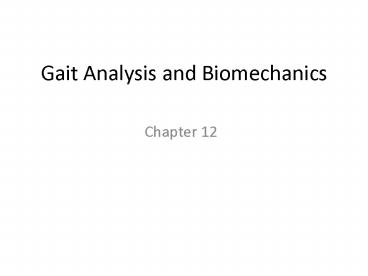Gait Analysis and Biomechanics - PowerPoint PPT Presentation
1 / 38
Title:
Gait Analysis and Biomechanics
Description:
Ankle Rockers (Perry) First rocker: ankle platarflexion after heelstrike. Second Rocker: ankle dorsiflexion. Foot is stationary. Tibia is rotating over the foot ... – PowerPoint PPT presentation
Number of Views:1776
Avg rating:3.0/5.0
Title: Gait Analysis and Biomechanics
1
Gait Analysis and Biomechanics
- Chapter 12
2
Overview
- Defining the gait cycle
- Guessing game sagittal joint kinematics
- Sprinting kinematics
- Ground reaction forces
- Walking at different speeds
- Running
- Implications on Joint Moments
- One pathology
3
Basic Vocabulary
- The gait cycle initial contact of one leg to
initial contact of the same leg - E.G. right heelstrike ? right heelstrike
- Includes two phases
- Stance Phase when the foot is on the ground
- Swing Phase when the leg is swinging forwards
SWING
SWING
SWING
4
Basic Vocabulary
- Includes important events
- Initial contact (heelstrike)
- Toe-off
- Opposite toe-off (e.g. when the left leg leaves
the ground) - Opposite initial contact (e.g. when the left leg
finishes swinging and hits the ground again)
5
Basic Vocabulary
- Base of support
- At heelstrike, you are in double limb support
- In the middle of stance phase, you are in single
limb support - After opposite heelstrike, you are once again in
double limb support
SWING
SWING
SWING
6
Cadence and Step Length
- Step Length
- distance from one foot strike to the next (left
to right or right to left) - about 0.75 m for normal adults
- Stride Length (one gait cycle)
- two successive steps (by both left and right
feet) - about 1.5 m for normal adults
7
- Cadence
- number of steps (left and right) taken per
minute - about 110 st/min for normal adults
- Like a pendulum, lower-limb swings at a frequency
(cadence) inversely proportional to its length,
so shorter people have a higher cadence.
8
- Velocity
- about 1.5 m/s or 5 km/hr in normal adults
- Velocity stride length x cadence
- 120
- and therefore
- Stride length 120 x velocity
- cadence
9
Children
- Children have shorter legs, so cadence is
increased - 170 st/min at age 1 yr to 140 st/min at 7y
- Stride length is roughly the same as height
(stature), so a child 0.5 m tall will have an
expected stride length of about 0.5 m - Velocity is roughly 1 stature/s, so a child 0.5 m
tall will have an expected walking velocity of
about 0.5 m/s
10
Guessing Game
- Sagittal plane joint angle
- Graphed for one side from heelstrike to
heelstrike - Vertical line separates stance phase from swing
phase
11
Joint Kinematics sample
- Ankle
Dorsiflexion
Plantarflexion
Heelstrike
Heelstrike
Toe-off
12
Joint Kinematics
- Ankle
Dorsiflexion
Plantarflexion
Heelstrike
Heelstrike
Toe-off
13
Ankle Rockers (Perry)
- First rocker ankle platarflexion after
heelstrike - Second Rocker ankle dorsiflexion
- Foot is stationary
- Tibia is rotating over the foot
- Third rocker Forefoot dorsiflexion as heel rises
(foot rocker)
14
Knee
Flexion
Extension
Heelstrike
Heelstrike
Toe-off
15
Hip
Flexion
Extension
Heelstrike
Heelstrike
Toe-off
16
Sprinting looks quite different
- Note femur parallel to ground
- Note clearance
17
Ground Reaction Force
- (Newtons 3rd Law of motion)
- Walking
- Heel strike transient
- Slow
- Fast
- Running
- No double-limb support
18
One key to understanding gait
- Moments!
19
External Moments
- Hip
- Knee
- Ankle
20
External Moments
- Hip
- Knee
- Ankle
21
External Moments
- Hip
- Knee
- Ankle
22
External Moments
- Hip
- Knee
- Ankle
23
External Moments
- Hip
- Knee
- Ankle
24
Key to Understanding Pathological Gait
- MOMENTS!
- Example what if quadriceps is weak?
25
Whats the external moment on the knee? Flexor
or extensor?
26
Model
- What muscles must resist an external knee flexor
moment?
27
Resisting a moment
- The knee extensors must resist an external knee
flexion moment - What are the knee extensors?
- What if they are weak?
28
Adaptations
- What can be done to protect quads?
- Reduce flexion moment
- How?
- Affect moment arm
- How?
- Affect vector direction
- Affect joint center
29
Adaptations
- What can be done to protect quads?
- Reduce flexion moment
- Move knee center back
- Move GRF direction forward
30
Anterior Trunk Lean
31
Other solutions
- Knee hyperextension
- Dynamic Limb Retraction
- Hand on thigh
32
Applications of Net Moments
- Related to walking
- Frontal Plane
33
- Identify
- Direction of moment about right hip when left leg
is off the ground - Muscles that must fire to resist that moment
34
Question
- What happens if right abductors are weak?
- Trendelenberg Sign
35
What could a cane do at the hip?
- Construct a free body diagram that demonstrates
how the use of a cane can alleviate compression
on the hip
36
(No Transcript)
37
Weight on one leg large moment resisted by
abductors
38
Summary
- Walking and running are complex cyclic motions
that involve interaction of both limbs and large
sagittal plane motion - Ground reaction forces and joint moments improve
understanding of normal and pathological gait































